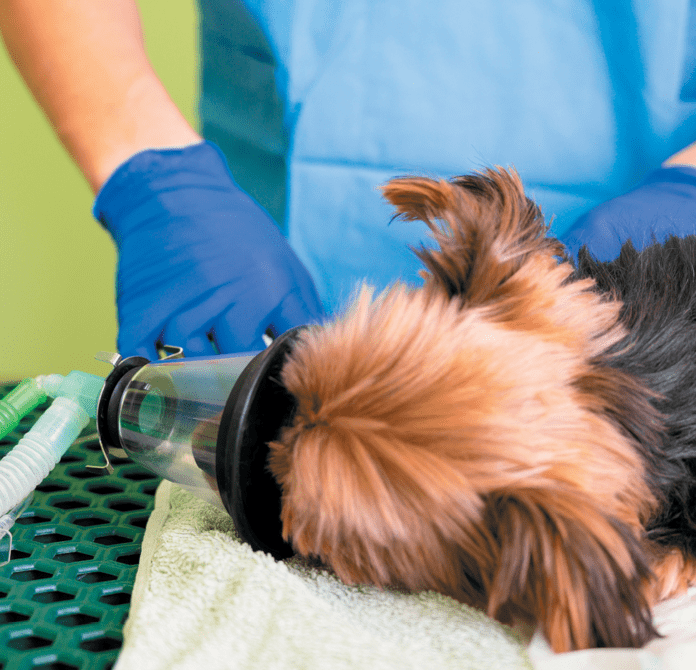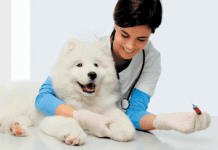In 2008, the risk of death for a healthy dog undergoing anesthesia was deemed to be one in 2,000, according to a study that appeared in the journal Veterinary Anaesthesia and Analgesia. That risk is probably even lower now. Monitoring techniques and anesthetic drugs themselves keep improving. But just as for people, the risk is not zero. Indeed, when researchers included dogs with health problems along with healthy dogs in their 2008 assessment, the risk of death with anesthesia was considered to be as high as one in 600.
Understandably, people are scared. In fact, veterinarians have noted that in a number of cases, a dog’s human family member decides against their dog having an operation not because of the expense but because of fear of their pet being “put under.”
That fear needs to be squared with the fact that veterinary advice for your dog to have surgery could well be in your future. She’ll need dental work, or a spay, or will have torn a ligament that requires a surgical repair. Or she’ll have a mass that should be removed. Even MRI and CT scans necessitate the use of anesthesia so a dog will stay completely still to get a clear image.
How best to position anesthesia in your mind so that you can make the right decision for your pet?
First, it’s important to acknowledge that certain dogs need special consideration.
Breed. Greyhounds have a longer recovery time after the administration of certain anesthetic drugs because of the way they metabolize them. And brachycephalic breeds —those with flat faces, such as pugs, bulldogs, and Boston terriers — are more prone to airway-related complications while anesthetized.
Size. Anesthesia increases the risk for hypothermia — the body’s temperature falling too low. Toy breeds are most prone, particularly if they weigh fewer than 10 to 12 pounds. Toy breeds are also more difficult to intu-
bate and easier to over-dose than larger dogs.
Weight. Over-weight dogs are at greater anesthesia risk. In fact, if a surgery is not an emergency, the vet might suggest helping an overweight dog to lose a few pounds before undergoing an operation.
Fortunately, even for dogs at greater risk, the odds are improving that anesthesia will not cause death or other complications, including post-surgical vomiting, low blood pressure, aspiration pneumonia, or cardiac arrhythmia. That’s because of the improvements in patient monitoring. Several decades ago, the extent of the monitoring may have been performing an EKG on a dog during an operation to assess the electrical activity of the heart and attaching a blood pressure cuff. Today, dogs are continually checked during surgery for blood oxygen saturation, body temperature, and capnography, which reflects how well the patient is breathing and whether carbon dioxide is being expelled from the body.
In addition, improvements in anesthetic drugs themselves are making it easier for veterinary anesthesiologists to practice safer administration. There are shorter-acting medications whose effects are more easily reversible if something goes wrong. And blood and urine samples examined beforehand let veterinarians know how well the liver and kidneys are working and which drugs a dog can handle. If one drug is deemed unsafe, there is often an alternative.
Indeed, anesthesiology has become safe enough for dogs, even for those whose health or breed is a complicating factor, that the American Veterinary Medical Association says the risks of anesthesia are usually minimal compared to the risk of not performing the procedure. That is, in virtually all cases, fear of anesthesia should not hold you back from a surgery your dog needs for better health, or to save her life.
To make anesthesia safer still, here are some things that the American Animal Hospital Association says you can do on your end.
Before the surgery
Be prepared to be asked the following questions by the veterinary clinic. Your answers can influence decisions about which anesthetic to give your dog as well as how to monitor her or test her before the surgery.
- How is your pet’s energy level? Does she tolerate exercise well?
- How often does she cough or sneeze? Any breathing changes?
- How often does she vomit?
- Any recent changes in her eating?
- Has your pet ever had anesthesia before? Were there any problems?
- What medical problems does she have?
List all her prescription medications, supplements (including cannabidiol, aka CBD), and over-the-counter medications. Which ones has she taken in the last 24 hours?
After the surgery
Some pain medications can last 8 to 12 hours in dogs. That means a dog may not have a bowel movement for up to 48 hours after a surgery. She may also feel especially sleepy and may be uncoordinated with jangly movements for a while. Additionally, she might have a lack of appetite. And she may cry or whine a little (the way some people feel dysphoric or still in some pain after anesthesia) or regurgitate a bit. With these possibilities in mind:
- Don’t give your pet stool softeners or other unauthorized over-the-counter medications that your veterinarian doesn’t know about.
- Don’t let her climb stairs, jump around, or roam outside alone for 24 hours.
- Of course, you should also follow any postoperative instructions provided by the veterinarian who performed the surgery.
Additionally, call your vet’s office if…
- Your dog seems extremely stressed and cries for more than an hour (or even less, if her behavior is very out of character). Your veterinarian or an after-hours emergency hospital may be able to provide a different pain medication or a sedative.
- Your dog isn’t eating when the veterinarian expected she would, vomits, develops diarrhea, or refuses to eat or drink for more than 12 hours.
- After 24 hours, your pet is still sleepy and can’t be easily woken by gentle petting.
- After 24 hours, your dog is still wobbly or bumping into furniture and walls.
- After 48 hours, your pet hasn’t pooped or is straining to poop.
Taking the right action at the right time will keep your dog safe and healthy going forward.





